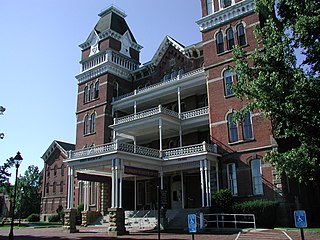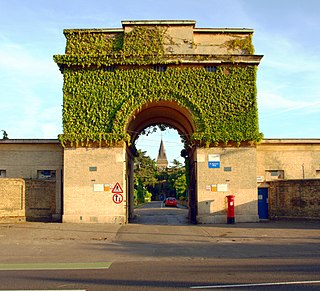
A psychiatric hospital, also known as a mental health hospital, or a behavioral health hospital, is a specialized medical facility that focuses on the treatment of severe mental disorders. These institutions cater to patients with conditions such as schizophrenia, bipolar disorder, major depressive disorder, and eating disorders, among others.

The Institute of Mental Health (IMH), formerly known as Woodbridge Hospital, is a psychiatric hospital in Hougang, Singapore.

The Kirkbride Plan was a system of mental asylum design advocated by American psychiatrist Thomas Story Kirkbride (1809–1883) in the mid-19th century. The asylums built in the Kirkbride design, often referred to as Kirkbride Buildings, were constructed during the mid-to-late-19th century in the United States.
Aradale Mental Hospital was an Australian psychiatric hospital, located in Ararat, a rural city in south-west Victoria, Australia. Originally known as Ararat Lunatic Asylum, Aradale and its two sister asylums at Kew and Beechworth were commissioned to accommodate the growing number of 'lunatics' in the colony of Victoria. Construction began in 1864, and the guardhouses are listed as being built in 1866 though the list of patients extends as far back as the year before (1865). It was closed as an asylum in 1998 and in 2001 became a campus of the Melbourne Polytechnic administered Melbourne Polytechnic's Ararat Training Centre.

The Athens Lunatic Asylum, now a mixed-use development known as The Ridges, was a Kirkbride Plan mental hospital operated in Athens, Ohio, from 1874 until 1993. During its operation, the hospital provided services to a variety of patients including Civil War veterans, children, and those declared mentally unwell. After a period of disuse the property was redeveloped by the state of Ohio. Today, The Ridges are a part of Ohio University and house the Kennedy Museum of Art as well as an auditorium and many offices, classrooms, and storage facilities.

Fulbourn Hospital is a mental health facility located between the Cambridgeshire village of Fulbourn and the Cambridge city boundary at Cherry Hinton, about 5 miles (8 km) south-east of the city centre. It is managed by the Cambridgeshire and Peterborough NHS Foundation Trust. The Ida Darwin Hospital site is situated behind Fulbourn Hospital. It is run and managed by the same trust, with both hospitals sharing the same facilities and staff pool.

St Bernard's Hospital, also known as Hanwell Insane Asylum and the Hanwell Pauper and Lunatic Asylum, was an asylum built for the pauper insane, opening as the First Middlesex County Asylum in 1831. Some of the original buildings are now part of the headquarters for the West London Mental Health NHS Trust (WLMHT).

Sunnyside Royal Hospital was a psychiatric hospital located in Hillside, north of Montrose, Scotland. It closed in 2011 and is now used for housing.

The Trans-Allegheny Lunatic Asylum was a psychiatric hospital located in Weston, West Virginia and known by other names such as West Virginia Hospital for the Insane and Weston State Hospital. The asylum was open to patients from October 1864 until May 1994. After its closure, patients were transitioned to the new William R. Sharpe, Jr. Hospital in Weston, named after William R. Sharpe Jr., a member of the West Virginia Senate. The hospital reopened as a tourist location in March 2008.

Knowle Hospital, was a psychiatric hospital that was repurposed as the village of Knowle near the town of Fareham in Hampshire, southern England, which opened in 1852 and closed in 1996.

Kew Lunatic Asylum is a decommissioned heritage-listed psychiatric hospital located between Princess Street and Yarra Boulevard in Kew, a suburb of Melbourne, Australia. Operational from 1871 to 1988, Kew Asylum was one of the largest asylums ever built in Australia. Later known as Willsmere, the complex of buildings were constructed between 1864 and 1872 to the design of architects G.W. Vivian and Frederick Kawerau of the Victorian Public Works Office to house the growing number of "lunatics", "inebriates", and "idiots" in the Colony of Victoria.

The Stanley Royd Hospital, earlier named the West Riding Pauper Lunatic Asylum, was a mental health facility in Wakefield, West Yorkshire. It was managed by the Wakefield and Pontefract Community Health NHS Trust.

The lunatic asylum, insane asylum or mental asylum was an institution where people with mental illness were confined. It was an early precursor of the modern psychiatric hospital.

St. Brendan's Hospital was a psychiatric facility located in the north Dublin suburb of Grangegorman. It formed part of the mental health services of Dublin North East with its catchment area being North West Dublin. It is now the site of a modern mental health facility known as the "Phoenix Care Centre". Since the official opening of the Richmond Lunatic Asylum in 1815 the Grangegorman site has continuously provided institutional facilities for the reception of the mentally ill until the present day. As such the Phoenix Care Centre represents the continuation of the oldest public psychiatric facility in Ireland.

Carrington Hospital is a former lunatic asylum and psychiatric hospital listed as a Category I building, located in Point Chevalier, Auckland.

Swanbourne Hospital is a heritage listed former mental hospital located in Mount Claremont, Western Australia. Built in 1904, it was the largest stand-alone psychiatric hospital in Western Australia for much of the twentieth century until its closure in September 1972. The hospital was originally known as Claremont Hospital for the Insane, Claremont Mental Hospital and Claremont Hospital. Following the closure of Claremont Hospital in 1972, the original 1904 section of the hospital functioned as the Swanbourne Hospital until 1985. The site was vacant from 1986, until renovated and reopened primarily as an aged care residence in 2018.

Prestwich Hospital is a mental health facility in Prestwich, Greater Manchester, England.

The Royal Dundee Liff Hospital, previously known as Dundee Lunatic Asylum and Dundee Royal Lunatic Asylum, was a mental health facility originally established in 1812 in Dundee, Scotland. It was originally located in premises in Albert Street Dundee, but later moved out of the town to new buildings in the nearby parish of Liff and Benvie. Buildings at Liff included Greystanes House, which was the main building, and, Gowrie House, which was the private patients' facility. Both Grade B listed buildings.
The Ospizio, originally known as the Casa di Carità, was a poorhouse in Floriana, Malta which cared for destitute elderly men and women, poor young women, and mentally ill patients during the 18th and 19th centuries. It also served as a women's prison. It was housed in a complex of buildings along the Floriana Lines overlooking Marsamxett Harbour, which are currently being restored and incorporated into the Malta International Contemporary Art Space (MICAS).
Villa Franconi was an 18th-century residential building in Floriana, Malta which was repurposed as a mental hospital known as the Franconi Asylum from 1835 to 1861. The building was demolished in the late 19th century.




















